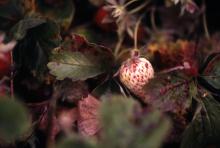See:
Strawberry Cultivar Susceptibility
Cause Diplocarpon fragarie, a fungus that overwinters on old infected leaves. The disease is frequent in northern Idaho and western Oregon and Washington. Conidia are produced in acervuli and are splashed to healthy tissue. Conidia are sticky and can directly penetrate the leaf cuticle. In spring rains, spores from just a few diseased plants can multiply and spread through the entire planting. Generally more severe in second- and third-year fields.
Symptoms Small, dark purple spots develop on upper leaf surfaces and remain dark purple. A white center never forms, as with common leaf spot. Spots have an irregular outline. If numerous, spots run together, and leaves appear scorched. In severe cases, foliage is reduced considerably, and plants may be stunted. Infected fruit has elongated, slightly sunken, reddish areas or streaks, but the marks disappear as the fruit ripens.
Cultural control
- 'Hood' and 'Rainier' are resistant. 'Northwest', 'Puget Beauty', 'Shuksan', and 'Totem' have intermediate susceptibility. 'Benton', 'Linn', 'RedCreast', 'Puget Crimson', and 'Quinault' are susceptible.
- Space plants so foliage dries rapidly after rain and irrigation.
- Use drip irrigation if possible. When using overhead irrigation, shorten sets and water at times that promote rapid drying of the foliage.
- Use optimal fertilization.
- Summer renovation will help reduce inoculum levels. In Oregon, it is recommended to renovate 2 to 4 weeks after the last harvest of June bearing types.
Chemical control
- Monterey Liqui-Cop at 1 to 2 teaspoons/gal water. H
- Topsin 4.5 FL at 15 to 20 fl oz/A plus another fungicide. Do not apply within 1 day of harvest. Group 1 fungicide. 24-hr reentry.
Note: When used for Botrytis control, iprodione has activity on leaf scorch.
Reference Zheng, J., and Sutton, J.C. 1994. Inoculum concentration, leaf age, wetness duration, and temperature in relation to infection of strawberry leaves by Diplocarpon earlianu. Canadian Journal of Plant Pathology 16:177-186.


